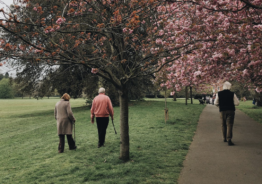The Leggings Rebellion!
Gemma Coombes, our Falls Prevention Instructor, is here with some great advice for the winter months, including how to keep our older users active!
Do you find it hard to stay active this time of year? I do – it’s so hard. Of course, I blame the damp weather, the dark nights, and the irresistible allure of my ridiculously fluffy TV blanket. It happens every year, but why is our sedentary behaviour so influenced by winter?
This year, just like every other year I planned to battle the winter blues and prevent my annual ‘winter body’ before it started, but it’s too late. Now I have to say – before it gets any worse. You see, when you work as a Falls Prevention Instructor here at Brio – you are never more than an arm’s reach away from lycra and within a matter of a few short weeks, gym leggings have become your new best friend. Only, they’re the kind of friend who never tells you that you have lipstick on your teeth or, in my case, bulges over my waistband. As the long warm days of summer drifted into the cooler dull days of autumn, my friendly leggings have squeezed me tighter, and tighter and tighter. Today, in a blink of an eye and without any warning at all, my besties gave it to me straight. There I was, sitting on the chair doing a cool down hamstring stretch with my wonderful older adults when my lycra leggings rebelled. Under strain for so long, who could blame them when the waistband clinging with all its might, finally gave up, rolling southwards under my belly and curling up tight like Mary Berry’s perfect swiss roll. A moment of realisation for me – even leggings have their limits.
Now I find myself writing this blog in an effort to stem the flow of the winter inevitable. It’s not just about my waist size of course, but how we feel in ourselves. Exercise is a fantastic mood-booster and if we need an extra lift then surely winter is the most important time.
So why do our habits change in the winter? Back in the summer, I walked the dog for miles and regularly attended the Neston gym – I even made a new friend (Mark the Gym Instructor) as we saw each other so often. But the inevitable psychological blanket we tuck ourselves in with on these cool wintery evenings crept up over my work leggings and I stopped. But why?
Health Scotland (www.nhsinform.scot) describe how light influences our sleep hormones. Light stops the production of the sleep hormone melatonin and causes us to wake up. In winter, when the daylight hours are shorter, our bodies are exposed to less light, so we produce more melatonin. This makes us feel more lethargic and tiredness creeps in, and even in some cases, so can the symptoms of depression.
That’s it then – I need more light. But it’s dark by four o’clock in the evening so that means only one thing – I need to stop pressing snooze twice (okay, realistically it’s at least four times) and get up earlier. Anyone who knows me well will tell you this is the exact opposite of how I currently live my life. I only get up early for flights, and even then, I will wait until the last possible minute. But in the name of science, my winter blues and most of all for my trusty leggings, I WILL get up early and go outside for a walk. My melatonin hormones won’t know what’s hit them, and neither will the dog.
Keeping up activity levels in older adults in winter
Winter has arrived in full force and it’s dark and gloomy outside – so how can we battle the winter blues and keep ourselves from falling into the trap of the TV blanket? Older adults are more prone to more sedentary behaviour during the winter months, so if you are over 65, or if you have a loved one that is, then read on for some tips to keep active this time of year.
- If the sun breaks through the clouds get outside and go for a walk. When exposed to light, our bodies produce melatonin – the hormone responsible for waking us up. So being outside can reduce the feeling of tiredness and lethargy.
- Wear layers and insulate your body. You are far more likely to exercise for longer outdoors if you’re warm. Remember, the recommended minimum activity levels for older adults is 150 minutes of activity spread across the week. To get these minutes in, make it comfortable – not painful!
- Use everyday activities as exercise but do more of them. For example, go up and down stairs twice instead of once, sit to stand from your chair three times every time you get up to make a drink, or even grab the tins of beans and do some bicep curls. Doing more everyday things more frequently can make a significant impact on your strength and fitness.
- Consider using a pedometer or fitness tracker. These objective measures will not lie to you! If your step count is low that day the pedometer will tell you. Set yourself an achievable goal based on your current level of fitness and work up to it.
- Ask your GP for a referral to our Strength & Balance Falls Prevention Programme. You don’t need to be a Brio member to join, just a referral from a Health Professional. The classes are free, held twice a week for 25 weeks and it’s well documented that exercising in a group can help with motivation. Plus, you will meet like-minded friends and have fun along the way.





